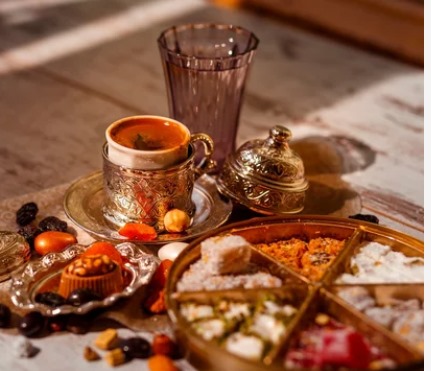
Traditional Turkish sweets

History of Baklava:
The history of baklava goes back to ancient times, and there are several theories about its origin. One of them claims that baklava was created in ancient Mesopotamia, about 2,000 years ago, and was known as “nut cake”. Others believe that baklava was first prepared in the Ottoman Empire. It was in the Ottoman Empire that it became more famous, perfected and acquired its modern form.
Turks attribute the creation of baklava to Ottoman cooks in palaces, who used a thin dough (similar to filo dough) that was considered a delicacy. In the Ottoman Empire, baklava became an integral part of festive meals, especially during major holidays such as Ramadan and Eid al-Adha.
The process of making baklava:
The main ingredients of baklava are filo dough, nuts (usually walnuts, pistachios or almonds), sugar or honey, and butter. The process of making it involves carefully rolling the dough into very thin layers, layering the nuts between them and pouring a syrup, which is often made from sugar, water and lemon juice. After baking, the baklava is usually cut into small diamonds or squares.
In Turkey, baklava is often served with tea or coffee, and is considered a delicacy to treat guests, especially during holidays.
In general, baklava is a symbol of Turkish culinary culture, and each country in the region has its own special way of making this dessert.
Künefe is a traditional Turkish dish that combines sweetness and savory, and is one of the most popular desserts in Turkey and other Middle Eastern countries. Its base is a kadayif (or kadayef) dough vermicelli, which is filled with grated cheese, most often mozzarella or a special Turkish cheese, and fried until golden brown. The künefe is then topped with a sweet syrup, which often consists of water, sugar, lemon, and sometimes rose water.
An important part of künefe is its presentation: it is usually served hot, sometimes with the addition of chopped pistachios or nuts. It is a dessert with a surprising combination of textures - a crispy crust and a soft cheese filling.
Künefe is often served on special occasions such as holidays or family gatherings, and is traditionally eaten with tea or coffee.
Turkish Delightor Lokum is a traditional Turkish sweet treat known for its soft, jelly-like texture and variety of flavors. It is made from sugar, water, starch, and may also include various additives such as nuts, rose water, lemon juice, or fruit. Most often, Lokum is coated with powdered sugar or coconut flakes.
Traditionally, Lokum is served with tea or coffee in Turkey, and is often used as a treat when visiting friends. It has become popular not only in Turkey, but also in other countries of the Middle East and the Balkans, as well as in parts of the Caucasus.
Interestingly, the name "Turkish Delight" in Arabic means "pleasant delight", which fully reflects its taste and texture.
Select your currency


